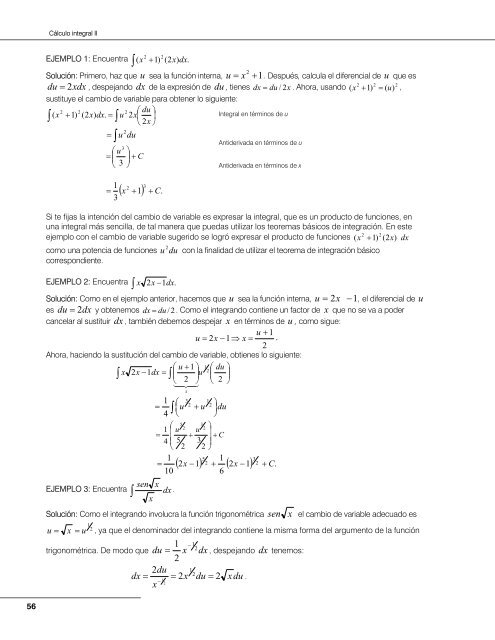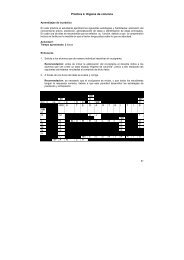Cálculo Diferencial e Integral II - Colegio de Bachilleres del Estado ...
Cálculo Diferencial e Integral II - Colegio de Bachilleres del Estado ...
Cálculo Diferencial e Integral II - Colegio de Bachilleres del Estado ...
You also want an ePaper? Increase the reach of your titles
YUMPU automatically turns print PDFs into web optimized ePapers that Google loves.
56<br />
<strong>Cálculo</strong> integral <strong>II</strong><br />
2 2<br />
EJEMPLO 1: Encuentra ∫ ( x + 1)<br />
( 2x)<br />
dx.<br />
2<br />
Solución: Primero, haz que u sea la función interna, u = x + 1.<br />
Después, calcula el diferencial <strong>de</strong> u que es<br />
2 2 2<br />
du = 2xdx<br />
, <strong>de</strong>spejando dx <strong>de</strong> la expresión <strong>de</strong> du , tienes dx = du / 2x<br />
. Ahora, usando ( x + 1)<br />
= ( u)<br />
,<br />
sustituye el cambio <strong>de</strong> variable para obtener lo siguiente:<br />
2 2<br />
2 ⎛ du ⎞<br />
∫ ( x + 1)<br />
( 2x)<br />
dx.<br />
= ∫ u 2x⎜<br />
⎟<br />
<strong>Integral</strong> en términos <strong>de</strong> u<br />
⎝ 2x<br />
⎠<br />
2<br />
= u du<br />
∫<br />
3 ⎛ u ⎞<br />
= ⎜<br />
⎟ + C<br />
⎝ 3 ⎠<br />
=<br />
3<br />
2 ( x + 1)<br />
+ C.<br />
1 3<br />
Si te fijas la intención <strong>de</strong>l cambio <strong>de</strong> variable es expresar la integral, que es un producto <strong>de</strong> funciones, en<br />
una integral más sencilla, <strong>de</strong> tal manera que puedas utilizar los teoremas básicos <strong>de</strong> integración. En este<br />
2 2<br />
ejemplo con el cambio <strong>de</strong> variable sugerido se logró expresar el producto <strong>de</strong> funciones ( x + 1)<br />
( 2x)<br />
dx<br />
como una potencia <strong>de</strong> funciones u du<br />
2 con la finalidad <strong>de</strong> utilizar el teorema <strong>de</strong> integración básico<br />
correspondiente.<br />
EJEMPLO 2: Encuentra ∫ x 2x − 1dx.<br />
Solución: Como en el ejemplo anterior, hacemos que u sea la función interna, u = 2x −1,<br />
el diferencial <strong>de</strong> u<br />
es du = 2dx<br />
y obtenemos dx = du / 2.<br />
Como el integrando contiene un factor <strong>de</strong> x que no se va a po<strong>de</strong>r<br />
cancelar al sustituir dx , también <strong>de</strong>bemos <strong>de</strong>spejar x en términos <strong>de</strong> u , como sigue:<br />
u + 1<br />
u = 2x<br />
−1<br />
⇒ x = .<br />
2<br />
Ahora, haciendo la sustitución <strong>de</strong>l cambio <strong>de</strong> variable, obtienes lo siguiente:<br />
⎛ u + 1 ⎞ 1 ⎛ du ⎞<br />
⎜<br />
⎟ 2<br />
∫ x 2x<br />
−1dx = ∫ u ⎜<br />
⎟<br />
⎝ 2 ⎠ ⎝ 2<br />
14243<br />
⎠<br />
sen x<br />
EJEMPLO 3: Encuentra ∫ dx .<br />
x<br />
x<br />
1 3 1 ⎛ 2 2<br />
=<br />
⎞<br />
∫ ⎜u<br />
+ u ⎟du 4 ⎝ ⎠<br />
⎛ 5 3<br />
2 2 ⎞<br />
1 ⎜ u u ⎟<br />
=<br />
+ C<br />
⎜ +<br />
4 5 3 ⎟<br />
⎝ 2 2 ⎠<br />
1<br />
5 1<br />
3<br />
= 2x<br />
−1<br />
2 + 2x<br />
−1<br />
2 + C<br />
10<br />
6<br />
( ) ( ) .<br />
Solución: Como el integrando involucra la función trigonométrica sen x el cambio <strong>de</strong> variable a<strong>de</strong>cuado es<br />
1<br />
2<br />
u = x = u , ya que el <strong>de</strong>nominador <strong>de</strong>l integrando contiene la misma forma <strong>de</strong>l argumento <strong>de</strong> la función<br />
1 − 1<br />
Anti<strong>de</strong>rivada en términos <strong>de</strong> u<br />
Anti<strong>de</strong>rivada en términos <strong>de</strong> x<br />
trigonométrica. De modo que du = x<br />
2<br />
2dx<br />
, <strong>de</strong>spejando dx tenemos:<br />
2du 1<br />
2<br />
dx = = 2x<br />
du = 2<br />
− 1<br />
2 x<br />
x du .

















